PREVIOUS
Geographical indications of Tamil Nadu – Part 1
November 13 , 2023
787 days
47433
0
(இதன் தமிழ் வடிவத்திற்கு இங்கே சொடுக்கவும்)
Geographical Indications
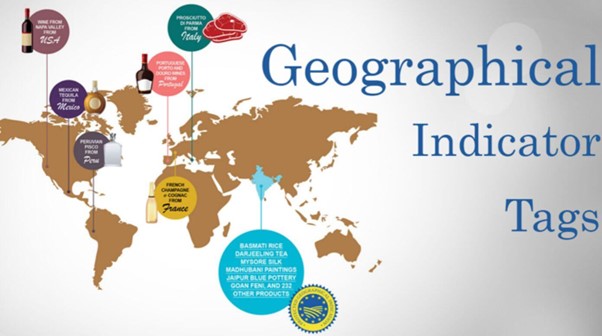
- GI Tag stands for Geographical Indication, which is a name or sign given to a certain product.
- It has a specific relation with geographical locations.
- The Geographical Indications (GI) have used a certification that the product is produced as per traditional methods.
- It has a particular reputation because of the geographical origin.
- A geographical indication right allows those who have the right to use the indication.

- It is preventing the third party from using it if their product does not meet the applicable standards.
- A geographical indication (GI) is a label placed on products that have a specific geographical origin.
- It has qualities or a reputation that stems from that origin.
- Such a name conveys a sense of quality and uniqueness.
- It is primarily attributable to its origin in that specific geographical location.
- In India, products with the Geographical Indication label are regarded as invaluable treasures of incredible India.
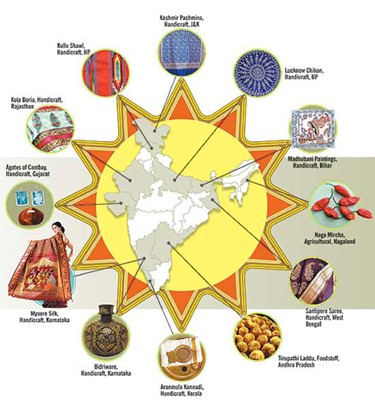
-
Geographical indications are commonly used for agricultural products, foods, wine and spirits, handicrafts, and industrial products.
-
A geographical indication can be registered for a period of ten years.
-
It can be renewed for a further period of ten years.
- A GI or Geographical Indication is a name or a sign given to certain products that relate to a specific geographical location or origins like a region, town or country.
- GI Tag ensures that none other than those registered as authorized users are allowed to use the popular product name.
- In order to function as a GI, a sign must identify a product as originating in a given place.
Historical Background
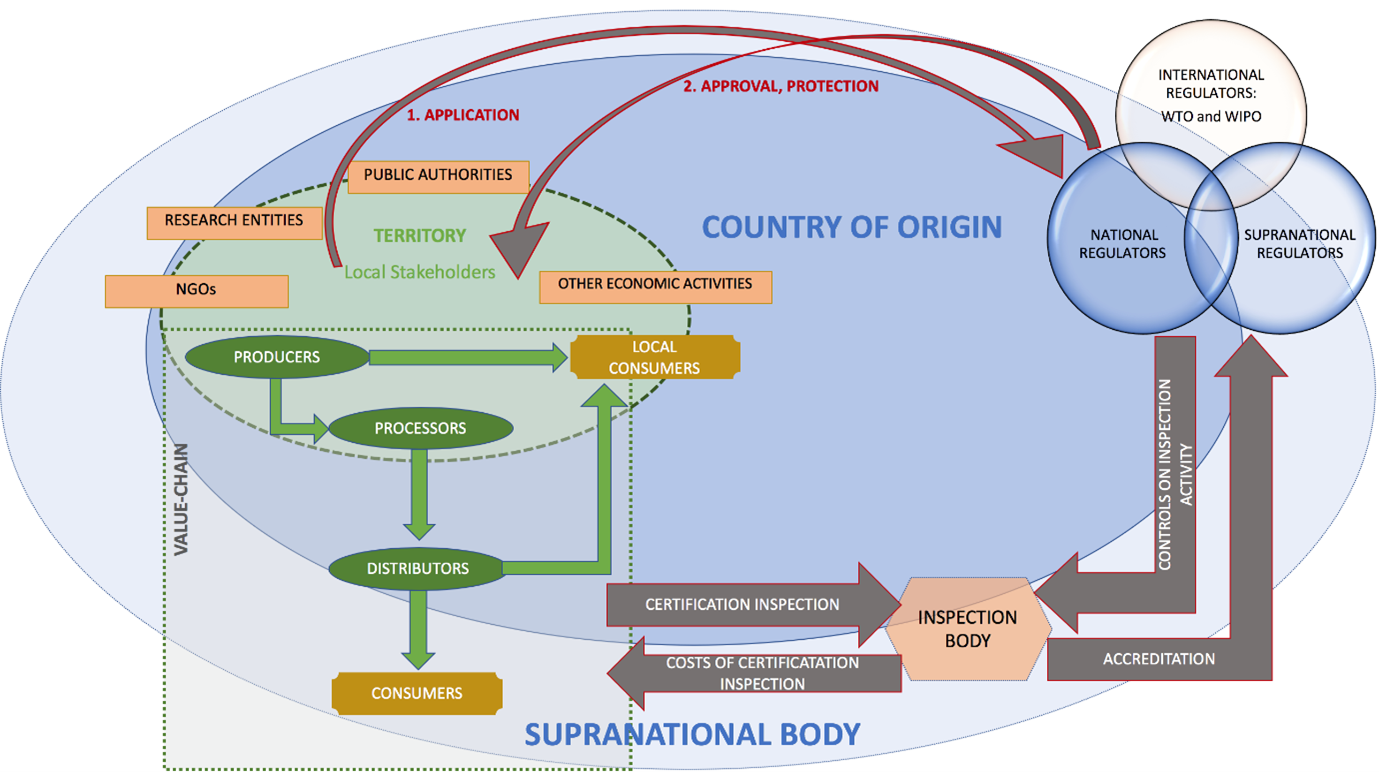
- The Geographical Indications of Goods (Registration and Protection) Act, 1999 was passed by Parliament in December 1999.
- This Act aims to improve the registration and protection of geographical indications relating to goods in India.
- The Controller General of Patents, Designs, and Trade Marks, who also serves as the Registrar of Geographical Indications, would be in charge of enforcing the Act.
- Geographical Indications Registry is located in Chennai.
- The Act went into effect on the 15th of September, 2003.
- Geographical Indication Registry comes under the Department of Industry Promotion and Internal Trade, Ministry of Commerce and Industry.

The organization that approves and regulates GI Tag
International Level
- The Paris Convention for the Protection of Industrial Property includes geographical indications as a component of intellectual property rights (IPRs).
- The World Trade Organization's (WTO) Agreement on Trade-Related Aspects of Intellectual Property Rights also governs GI (TRIPS).
India
- Geographical Indications registration in India is governed by the Geographical Indications of Goods (Registration and Protection) Act, 1999.
- It was gone into effect in September 2003.
- The first product in India to be accorded with GI tag was Darjeeling tea in the year 2004-05.
Benefits of GI Tags
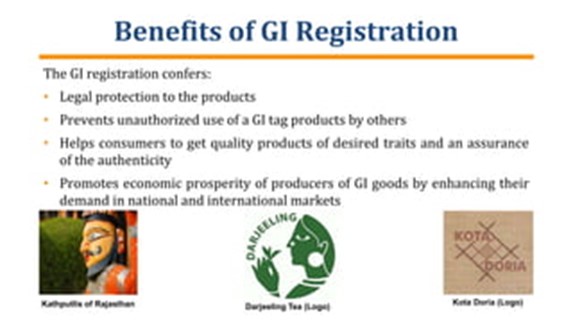
- The Geographical Indication registration confers the following benefits:
- It gives legal protection to the products.
- It prevents unauthorized use of GI tag products by others.
- It helps consumers to get quality products of desired traits and is assured of authenticity.
- It promotes the economic prosperity of producers of GI tag goods by enhancing their demand in national and international markets.
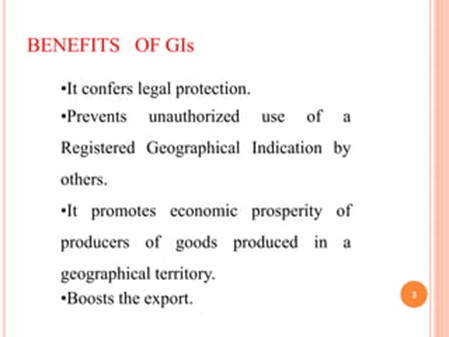
Security
-
Once the GI protection is granted, no other producer can misuse the name to market similar products.
-
It also provides comfort to customers about the authenticity of that product.
Registered proprietor of a geographical indication
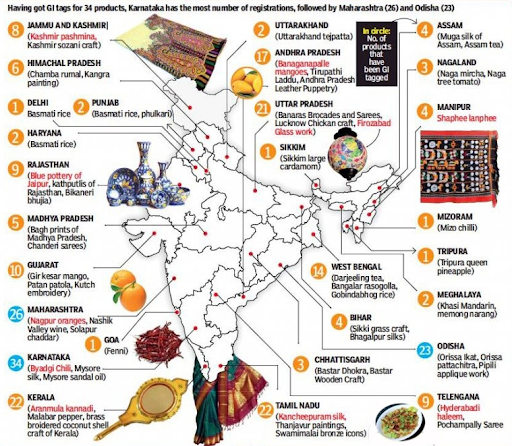
-
Any association of persons, producers, Organisation or authority established by or under the law can be a registered proprietor.
-
Their name should be entered in the Register of Geographical Indication as registered proprietor for the Geographical Indication applied for.
Period of the registration of Geographical Indication
-
The registration of a geographical indication is valid for a period of 10 years.
-
It can be renewed from time to time for further period of 10 years each.

Significance of GI Tags
-
A geographical indication right allows those who have the right to use the indication to prevent it from being used by a third party whose product does not meet the applicable standards.
-
For example, in the jurisdictions the Darjeeling geographical indication is protected.
-
Producers of Darjeeling tea can prohibit the use of the term "Darjeeling" for tea that was not grown in their tea gardens or was not produced.
-
It will be in accordance with the standards outlined in the code of practice for Darjeeling tea.
-
A protected GI, on the other hand, does not allow the holder to forbid someone from making a product using the same methods as those specified in the standards for that indication.

-
Typically, GI tag protection is obtained by acquiring a right over the sign that constitutes the indication.
-
Geographical indications are mostly traditional products made by rural communities over generations that have gained market prominence due to their precise qualities.
-
The recognition and protection of these products' markets enable the producer community to devote.
-
It is maintaining the precise qualities of the product on which the reputation is built.
-
This may also allow them to pool their resources to promote the product's reputation.
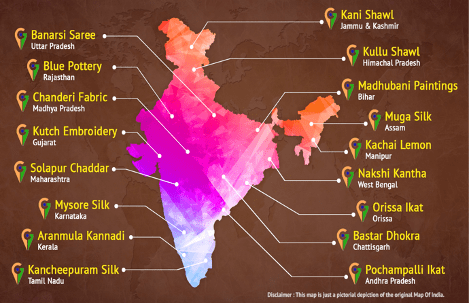
Impacts of GI on rural development
-
The supply chain is organized around a shared product reputation.
-
Price increases and price stability for the GI product.
-
Value is added when it is distributed at all levels of the supply chain.
-
Natural resources, on which the product is based, can be preserved.
-
Traditions and traditional expertise must be preserved.
-
Tourism can be improved.
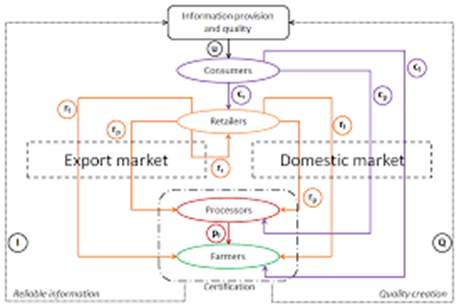
- Tamil Nadu tops GI chart with 58 tags.
- Three more products, unique to Tamil Nadu, have recently obtained the Geographical Indication (GI) tag.
- Hence, strengthening the state’s top rank in the list of GI products.
- The GI registry is to confer GI recognition for Jaderi Tiruman (Namakatti) from Tiruvannamalai.
- It adores the foreheads of top deities and Vaishnavites all over the world.
- The delicious Matti Banana of Kanyakumari district and the Chedibutta sarees of Tirunelveli district.
- Application for the third GI tag-winner, Chedibutta Sarees, has been made by Veeravanallur Sowrashtra Weavers Cooperative Production and Sales Society Limited in Tirunelveli district.
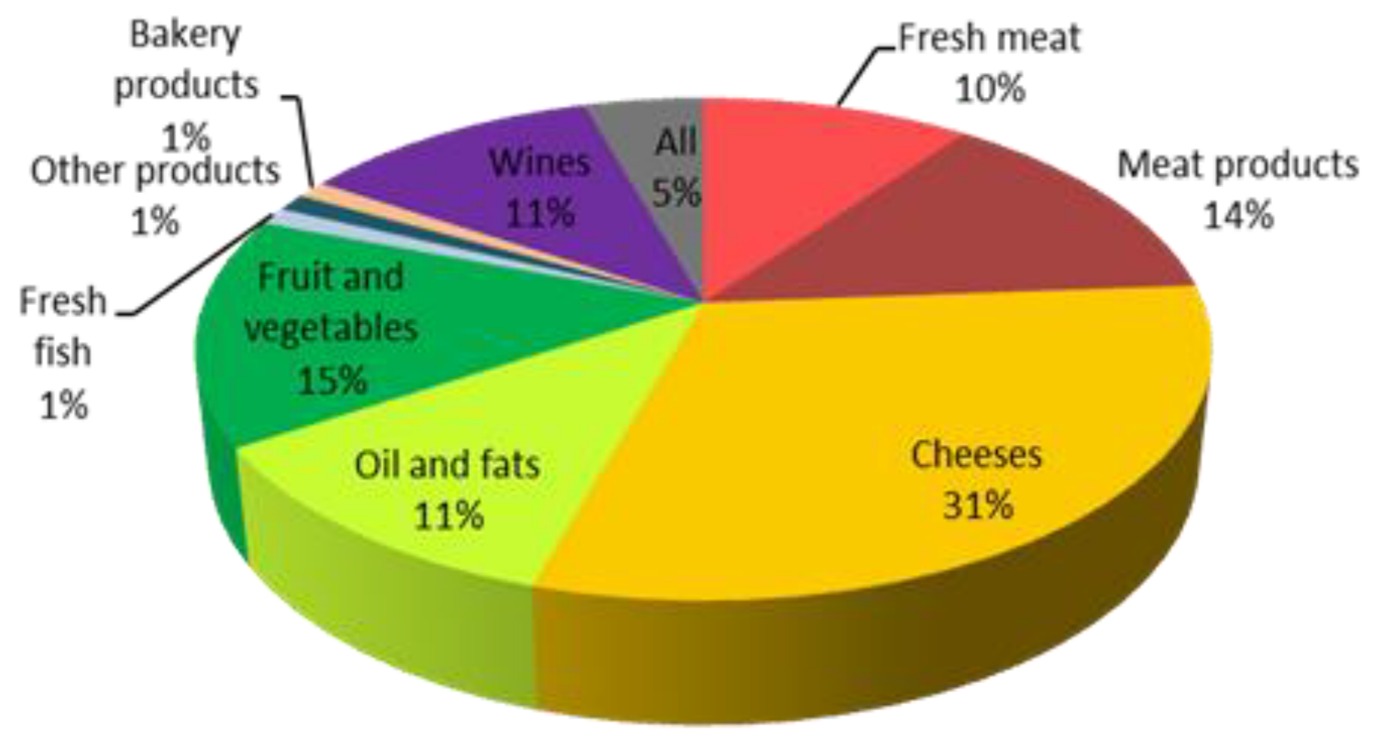
- These are the new entrants to the GI hall of fame which has nearly 420 products so far.
- While Tamil Nadu’s tally has reached 58 now, Uttar Pradesh is in second position with 50-plus products, followed by Karnataka with 48.
- It is adding that the tally is as of April 2023.
- Some more products have been granted the GI tag during the April-July period as well.
- Sanjai Gandhi alone has obtained GI recognition for 40 products for various cooperative societies and government departments.
- Ever since Tamil Nadu government appointed him attorney two years ago, he obtained 17 GI tags.
- At least 15 products from Tamil Nadu are awaiting the GI registry’s nod, he said.
Recent GI Tag of Tamil Nadu
Udangudi Panangarupatti
- Udangudi ‘Panangkarupatti’ (palm jaggery/ gur) has been given a Geographical Indication (GI) tag.
- It is prepared using the palm sap collected from the inflorescence of palmyra trees that grow on the red sand dunes in and around the Tiruchendur region, such as Srivaikuntam, Thoothukudi, Eral, Sathankulam, and Tiruchendur taluks.
- The application for this was filed by Tirunelveli District Palmyrah Products Cooperative Federation Limited and Patent Information Centre, Tamil Nadu State Council for Science and Technology.
- The palm jaggery preparation procedure in this area is traditional till date without inclusion of any additional modern strategies.
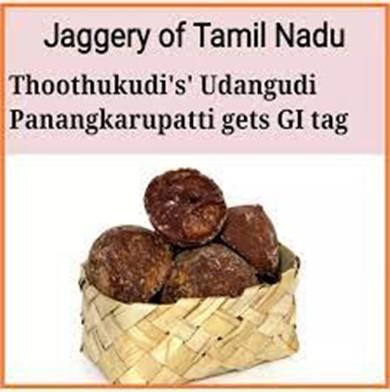
- Triple super phosphate and phosphoric acid are used in many other areas, but no such chemical additives are used in Udangudi Panangkarupatti.
- The karupatti prepared from the palm sap from the region around Udangudi in Tiruchendur taluk in Thoothukudi district has some uniqueness.
- This is due to presence of red sand dune soil found in the region.
- This soil holds less groundwater.
- The moisture content in the atmosphere is less because of the dry climatic condition.
- It leads to high sucrose content, in turn adding taste.
- The region’s dry climate is also suitable for storage of karupatti for a longer duration.
- Details in the GI filing mentioned that Udangudi jaggery was even exported to foreign countries, including Sri Lanka, Malaysia and Singapore.
- Moreover, Madurai and Tirunelveli had more than 500 wholesale dealers for Udangudi jaggery.
Method of production
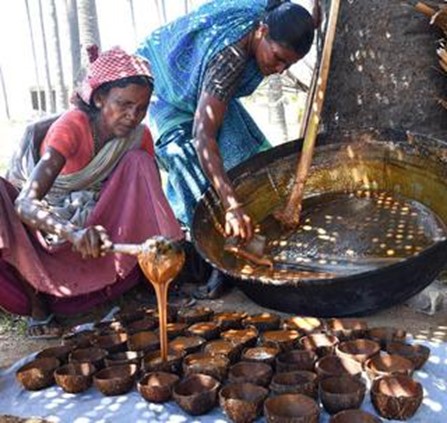
- The inner surface of the earthen pots is coated with lime to prevent fermentation.
- The sap (padhaneer) is collected drop by drop into small earthen pots tied to the stalk.
- It is collected only from March-April to June-July.
- The collected padhaneer is then boiled in large vessels.
- It remains in solid state during summer and semi-solid state during rainy season.
- Many store it in containers and use it for months together.
- It is added to food items as sweetener.
- Castor seeds are powdered and sprinkled gently on the jaggery as an antifoaming agent.
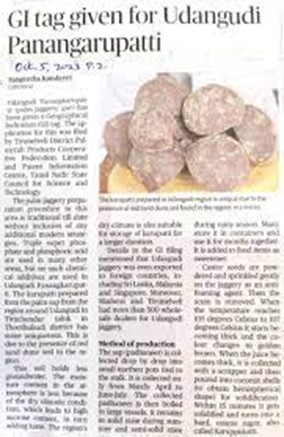
- Then the scum is removed.
- When the temperature reaches 105℃ to 107℃, It starts becoming thick and the colour changes to golden brown.
- When the juice becomes thick, it is collected with a scrapper and then poured into coconut shells (to obtain hemispherical shape) for solidification.
- Within 15 minutes it gets solidified and turns into a hard, coarse sugar, also called ‘Karuppukatti’.
- Usually, the palmyra climber crushes the flowering shoots of male palmyra trees and the inflorescence of female palmyra trees, and ties an earthen pot to the stalk the previous evening to collect the sap oozing overnight.
- Each tree can produce up to 2.25 litres of palmyra sap.
- Fresh sap is a good source of Vitamin B complex, according to the documents approved by the Geographical Indication Registry.
- Traditionally, lime obtained from slaked sea shells is used in the Tiruchendur region, whereas slaked rock lime in all other places.
- It is allowed to dry for an hour before it turns to palm jaggery.
- A 15-litre can of padhaneer can produce around 4.5 kg of palm jaggery.
- The packing of the Panangarupatti is also quite interesting: Bags are made by knitting together palm leaves, which are then covered by two palm leaf petty.
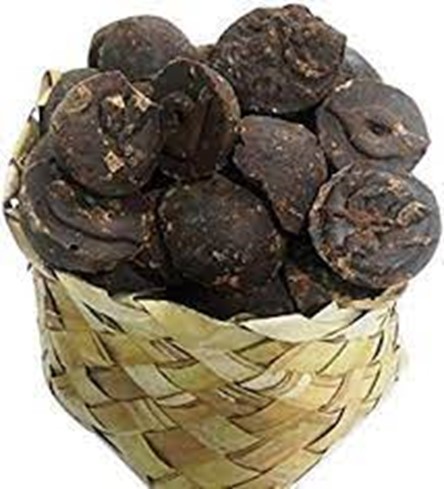
Leave a Reply
Your Comment is awaiting moderation.


